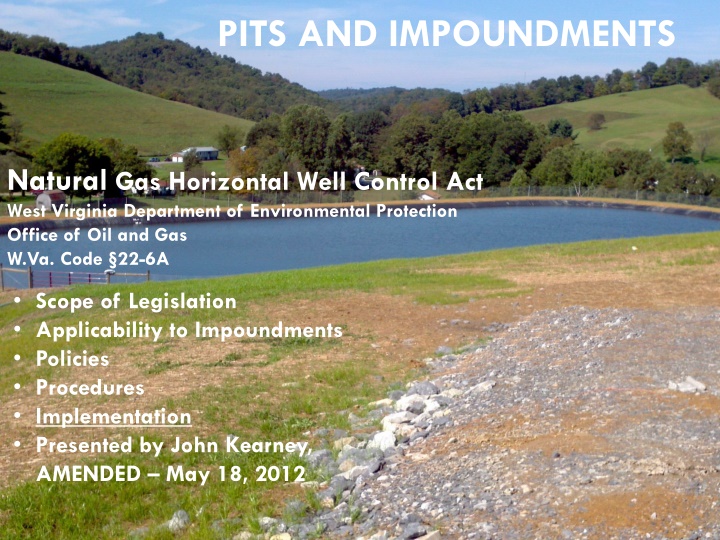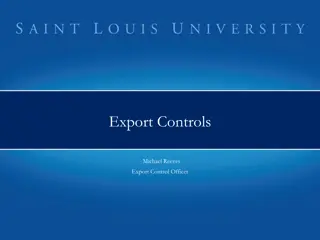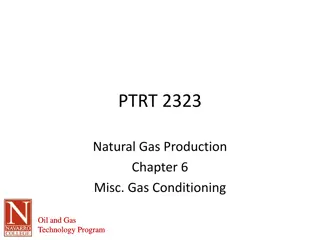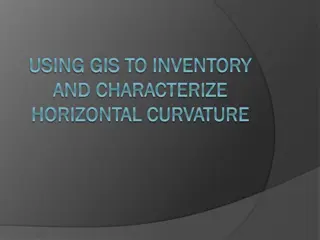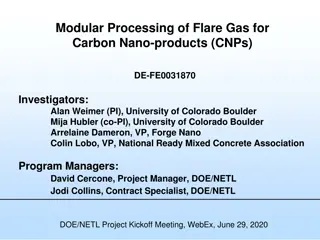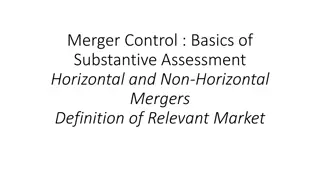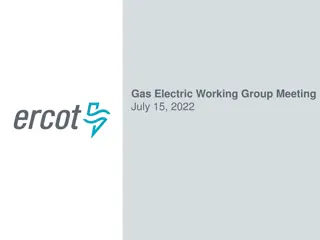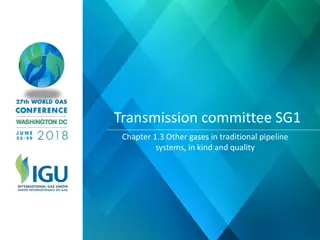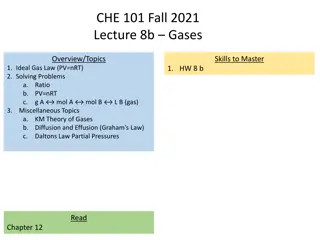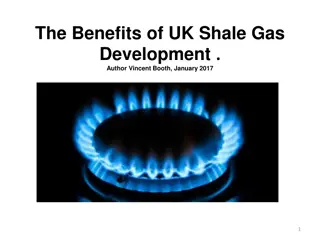Regulations on Impoundments in Natural Gas Horizontal Well Control
The document discusses the regulations, guidelines, and procedures concerning impoundments and pits in relation to natural gas horizontal well operations in West Virginia. It covers topics such as certificate of approval, notification to property owners, safety studies, and definitions of terms related to impoundments. The legislation aims to ensure the safe and proper management of fluid retention areas in the context of horizontal well development.
Download Presentation

Please find below an Image/Link to download the presentation.
The content on the website is provided AS IS for your information and personal use only. It may not be sold, licensed, or shared on other websites without obtaining consent from the author.If you encounter any issues during the download, it is possible that the publisher has removed the file from their server.
You are allowed to download the files provided on this website for personal or commercial use, subject to the condition that they are used lawfully. All files are the property of their respective owners.
The content on the website is provided AS IS for your information and personal use only. It may not be sold, licensed, or shared on other websites without obtaining consent from the author.
E N D
Presentation Transcript
PITS AND IMPOUNDMENTS Natural Gas Horizontal Well Control Act West Virginia Department of Environmental Protection Office of Oil and Gas W.Va. Code 22-6A Scope of Legislation Applicability to Impoundments Policies Procedures Implementation Presented by John Kearney, AMENDED May 18, 2012
Scope of Legislation as it relates to Impoundments and Pits Office of Oil and Gas 2 Three Sections: 22-6A-9. Certificate of Approval Establishes rules for Pits and Impoundments not associated with a specific well work permit (Centralized). Mandates Centralized Pits and Impoundments receive Certificate of Approval. Similar to Dam Safety Rules. (h) Each certificate of approval issued by the secretary pursuant to the provisions of this article may contain other terms and conditions the secretary prescribes. WV DEP Horizontal Well Act Impoundment Presentation, Amended 5/18/2012
Scope of Legislation as it relates to Impoundments and Pits, continued. Office of Oil and Gas 3 22-6A-10. Notice to property owners. Requires notification of centralized impoundment to owners of the surface tract prior to installation of impoundment. Also, because this activity is not associated with the permitted well work, a surface use agreement will be required for the placement of impoundments or pits 22-6A-23. Impoundment and pit safety study; rulemaking. Mandates that by January 1, 2013, DEP reports to the Legislature on the safety of pits and impoundments utilized pursuant to section nine of this section. Upon a finding that greater monitoring, safety and design requirements or other specialized permit conditions are necessary, the secretary shall propose for promulgation legislative rules establishing these new requirements.
Definitions Office of Oil and Gas 4 The following definitions are to be used: Impoundment A man-made excavation or diked area for the retention of fluid. By convention - containing freshwater only. Pit a man-made excavation or diked area that contains or is intended to contain an accumulation of process waste fluids, drill cuttings or any other liquid substance generated in the development of a horizontal well and which could impact surface or groundwater. Any mixture of waste will classified as a pit. Centralized an impoundment or pit that is NOT on a permitted drilling location. Associated an impoundment of pit that IS on a permitted drilling location. Certificate of Approval a formal approval for centralized impoundments or pits.
Applicability of 22-6A-9 Office of Oil and Gas 5 Impoundments greater than 210,000 gallons (5,000 bbls). Above ground diked impoundments greater than 210,000 gallons. (Portable temporary structure, not tanks) Impoundments not associated with a specific well work permit. Establishes rules and procedures to issue Certificate of Approval for impoundment and pits NOT associated with well permits. Exceptions: Impoundments associated with well work permit. Farm Ponds.
Exceptions to 22-6A-9 Office of Oil and Gas 6 Let s get the exceptions out of the way. Associated Impoundments: Nothing has change by this legislation. Regulated by W. Va. Rule 35-4-21 Reclamation time frames same as well pad. We will standardize communication process, forms, submittals. We will also begin assigning numbers to all impoundments and enter in our ERIS data base. You will submit these on paper and via Email. New Email: depimpoundments@wv.gov
Exceptions to 22-6A-9, cont. Office of Oil and Gas 7 Farm Ponds Farms Pond are exempt from Certificate of Approval rule. They are not exempt from US Army Corps of Engineer or USEPA. United States Department of Agriculture s Natural Resources Conservation Service Conservation Practice Standard - Ponds (Code 378) There are standards for placement in low hazard area, and design standards for spillway, drainage area, size and use. Farm Pond Fact Sheet Farm Pond Standard See Appendix Pay attention to US Army Corps of Engineer and EPA Clean Water Act regulations.
Centralized Impoundments 22-6A-9 Office of Oil and Gas 8 Scope of Legislation: Centralized pits (not on a well permit) will require a Certificate of Approval. This is very similar to a Dam Safety Certificate of Approval. Good for one year, renew annually, application fee $300, annual $100. To enlarge, alter, repair, remove or abandon an impoundment will require a modification to the Certificate of Approval, $300 Fee. Designs and plans will be charge of Professional Engineer, registered in WV. You have the right to appeal. You have six months to reclaim impoundment after expiration of approval. New forms Waste pits have more stringent design standards.
Application Process Office of Oil and Gas 9 Submit Application and Plans Application basic information With an Impoundment Certificate of Approval application, you will include: Engineered Construction Plans , WV P.E. Certified Erosion and Sediment Control Plan, WV P.E. Certified A Reclamation Plan Post-Construction and Post-Use, WV P.E. Certified . Impoundment Monitoring Plan, WV P.E. Certified Impoundment Maintenance and Emergency Plan, WV P.E. Certified Water Management Plan. How will you fill it? You will reference this water management plan once water begins moving to satellite well pads. Notifications: - See 22-6A-10 To surface owner. Copies of proof of delivery will be included with application. Also notice the above people within 7 days, but not less than 2 days, of the start of construction.
Elements of Plans Office of Oil and Gas 10 Engineered Plans. Waste Pits have more safe guards; duel liners, leak detection, groundwater monitoring. Reclamation Plans. Post-construction reclamation plan after you ve built it. Post-closure reclamation plan - after you ve closed it. Maintenance Plan. Scheduled maintenance, routine repairs. Monitoring and Emergency Plan. Inspections, emergency planning, and response. You will evaluate the location of impoundments and classify using dam safety Hazard Classification criteria.
Elements of Plans Office of Oil and Gas 11 Monitoring and Emergency Action Plan Hazard Classes Class 1 (High Hazard) Class 2 (Significant Hazard) Class 3 (Low Hazard) Class 4 (Negligible Hazard) Hazard Evaluation The applicant will survey surrounding area for potential hazards should pit or impoundment fail, paying attention to homes, structures, roads, etc. Example plans are coming. Modeled on Dam Safety regulations. Location and classification of new centralized impoundments will impact your emergency plan and how you prepare for an emergency. Monitoring and Emergency Action Plans will detail monitoring and emergency notification and procedures, and assess risk. Surface Owner Agreements Centralized impoundments and pits will be constructed on landowners who enter into lease agreements with you.
Water Management Plans Office of Oil and Gas 12 Water Management Plans (WMP) A WMP will be needed to fill your impoundment. Will also be needed if you will plan on diluting a waste pit with freshwater from a stream source (greater than 5,000 bbl. / month). Apply for WMP concurrently with Impoundment application or prior. A centralized impoundment WMP can be referenced for well pads. Will integrate with other WMP plans. Waste pits will be referenced in other WMP disposal. Waste pits may also be sources of other WMP. Waste Pits may need WMP if receiving water from stream or water utility.
A Word About Dams Office of Oil and Gas 13 Do not build a dam unless you intend to build a dam. Definition: - (See Impoundment Page Dam Definition) This is an option if you are willing to design and build to dam specifications. Height and volume driven. 25 tall embankment and 15 acre feet of water (116,375 bbls, 4.8 million gal) OR 6 tall embankment and 50 acre feet of water (387,917 bbls, 16.2 million gal) Impoundments often exceed the volume limit, but not the height limit. Incised volume does not count to total volume. Embankment height is key to definition of a dam. How to measure ? Where to measure from ? Generally, the base of any earth disturbance on the embankment.
Appropriate Location Due Diligence Office of Oil and Gas 14 Per 35-4-21.1 All pits and impoundments with capacity of greater than five thousand (5,000) barrels used in association with an oil and gas operation, shall be constructed only in locations appropriate for the storage of water, including wastewater, and shall be designed, constructed, located, maintained, and used in accordance with this rule and in such a manner as to minimize adverse environmental effects and to assure safety to the public. Responsibility of operator to consider history of location. Some historical mining locations may present water quality problems. Former industrial location could also present problems. Assure safety to surrounding communities, people, and environment.
Application Forms Office of Oil and Gas 15 To standardize how we communicate about impoundments, New impoundments and pits forms have been created: Permit Associated Impoundment / Pit Registration Centralized Impoundment / Pit Application Basic information will be captured. It will have checklists for required information and additional plans. All impoundments will get a number. We need to standardize names for tracking purposes. Remember standard nomenclature: Impoundment = Freshwater Pit = Waste All forms available at www.dep.wv.gov/oil-and-gas/impoundments
Application / Approval Process Office of Oil and Gas 16 Centralized Impoundments and Pits How-To 1. Complete and submit Centralized Impoundment / Pit Application . 2. Show proof of surface owner notification requirement. 3. Include all required plans, including Water Manage Plan. 4. Water Management Plan will be forwarded by OOG to Water Use section for review and approval. 5. Office of Oil and Gas will review application and plans. 6. Oil and Gas Inspector will visit to review Erosion & Sediment Control Plan. 7. WMP gets approved. 8. Application is approved then given Certificate of Approval . 9. You will receive Certificate of Approval and impoundment number. 10.At least 7 days prior to construction commencement, complete Notification of Impoundment / Pit Construction . Submit a copy of this form to Office of Oil and Gas, local Oil and Gas Inspector, and those requiring notification. 11.Build impoundment or pit. 12.Remember the WMP notification requirement prior to filling. 13.Submit As-built P.E. Certification (and other Waste Pit certified plans, required before filling. 14.You may now fill the impoundment or pit.
Application / Approval Process Office of Oil and Gas 17 Associated Impoundments and Pits How To . 1. Apply for well work permit as usual with impoundments included in your construction drawings, E&S Plans, etc. 2. Complete and submit Permit Associated Impoundment / Pit Registration with the application. 3. An impoundment number will be assigned and sent to you. 4. At least 7 days prior to construction commencement, complete Notification of Impoundment / Pit Construction . Submit a copy of this form to Office of Oil and Gas and to local Oil and Gas Inspector. 5. Build it. 6. Submit P.E. Certified As-Built Certification. 7. Fill the impoundment or pit. Notes on Water Management Plans. Since associated impoundments will be associated with a drilling permit, you will have already applied for a water management plan, or have done so concurrently. If you have an approved WMP, provide this number on application. If not, notify as pending . In no case will you pump large volumes of water without an approved WMP.
Impoundment Numbers Office of Oil and Gas 18 Examples of Types 000-FWC-0001 000-WPC-0001 000-FWA-0001 000-WPA-0001 Explanation of Number and Types 000 = County Code FWC = Fresh Water Centralized Impoundment not associated with API permit FWA = Fresh Water Associated Impoundment associated with API permit WPC = Waste Pit Centralized Pit not associated with API permit WPA = Waste Pit Associated Pit associated with API permit 0001 = Sequentially numbered by county
Centralized Pits - Key Elements Office of Oil and Gas 19 Centralized Pits will require geotechnical and groundwater investigation. More upfront planning and design. Groundwater wells, groundwater monitoring. Duel 60 mil liners, leak detection zone. Details available in Design and Construction Standards for Centralized Pits . These requirements are in the process of being codified.
All information available on internet: http://www.dep.wv.gov/oil-and-gas/Impoundments Office of Oil and Gas 20
Plan Submittal Office of Oil and Gas 21 Submit original paper copy of application to: West Virginia Department of Environmental Protection Office of Oil and Gas Impoundment Registration 601 57th Street, SE Charleston WW 25304 Email PDF file format of this application and all related engineering Plans to : Depimpoundments@wv.gov Any Questions can be forwarded to: John Kearney WV DEP Office of Oil and Gas John.J.Kearney@wv.gov
List of Forms and References All Forms and References will available on Office of Oil and Gas Web Page Office of Oil and Gas Forms References 22 Permit Associated Impoundment / Pit Registration - Form IMP-1A - Link Natural Gas Horizontal Well Control Act; W.Va. Code 22-6A Centralized Impoundment / Pit Application - Form IMP-1B - Link W.Va. Code 35-4-21 Construction of Pits and Impoundments with Capacity of Greater Than 5,000 bbl Notification of Impoundment / Pit Construction - Form IMP-2 - Link W.Va. Code 47-34 Dam Safety Rule Impoundment As-Built Certification - Form IMP-3 Link United States Department of Agriculture s Natural Resources Conservation Service Conservation Practice Standard - Ponds (Code 378) Centralized Impoundment / Pit Annual Recertification - Form - Link Farm Pond Fact Sheet Centralized Impoundment / Pit Modification and Closure Form Link Design and Construction Standards for Centralized Pits Notice of Application Form WW-6A Link Example Monitoring and Emergency Plan Example Maintenance Plan WV DEP Horizontal Well Act Impoundment Presentation, February 1st, 2012
FAQ Office of Oil and Gas 23 Q. Can we build an impoundment next to a permitted location, call it centralized and get a certificate of approval for it? A. Yes, if you have a surface use agreement with the surface owner. These impoundments are not on the permitted location. Also, they should be designed to maintain some degree of separation from permitted pad LOD. The two activities can not interfere with reclamation of the other. They will also require their own plans. Q. What about next to an existing, permit released pad? A. Yes, if you don t disturb the well pad. Q. If WV DEP give us a certificate of approval, are we exempt form US Army Corps of Engineer issues? A. No. The Corp of Engineers is diligent in their role of enforcing permitting requirements for work in the waters of the United States of America. You should consult with them before doing stream work.
Good Ideas Office of Oil and Gas 24 Water Level Markings Water Level in feet. Better monitoring, detect leaks
Good Ideas Office of Oil and Gas 25 Fence is up Neat location Good Berms and ditches Good Vegetation and veg. control. Well Maintained
Questions Office of Oil and Gas 26
